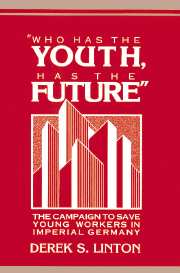Book contents
- Frontmatter
- Contents
- List of tables
- Acknowledgments
- 1 Introduction: the natural history of a social problem
- 2 Young laborers in the population, labor force, and industrial law: structural preconditions of the youth salvation campaign
- 3 Youth savers and youth salvation: the image of young workers and institutional reform
- 4 Vocation and civics: the continuation school in practice
- 5 Beleaguered churches: Protestant and Catholic youth work
- 6 The Socialist youth movement
- 7 Youth cultivation: the centralization and militarization of youth salvation
- 8 Preparing for motherhood: the inclusion of young working women in youth cultivation
- 9 Youth cultivation and young workers in war
- Epilogue and conclusion
- Notes
- Bibliography
- Index
Epilogue and conclusion
Published online by Cambridge University Press: 20 October 2009
- Frontmatter
- Contents
- List of tables
- Acknowledgments
- 1 Introduction: the natural history of a social problem
- 2 Young laborers in the population, labor force, and industrial law: structural preconditions of the youth salvation campaign
- 3 Youth savers and youth salvation: the image of young workers and institutional reform
- 4 Vocation and civics: the continuation school in practice
- 5 Beleaguered churches: Protestant and Catholic youth work
- 6 The Socialist youth movement
- 7 Youth cultivation: the centralization and militarization of youth salvation
- 8 Preparing for motherhood: the inclusion of young working women in youth cultivation
- 9 Youth cultivation and young workers in war
- Epilogue and conclusion
- Notes
- Bibliography
- Index
Summary
Although some significant modifications in official youth policy were introduced during the Weimar Republic and several major ones under the Nazi regime, nonetheless, in large measure the youth salvation campaign during the late Empire had established the discourse, the range of policy options, and the bureaucratic and institutional framework available to public officials through World War II and beyond. Certainly various aspects of youth cultivation were given more solid legal underpinnings during the Weimar Republic. Indeed, legislators passed a raft of legislation concerning youth, and various ministries issued a battery of decrees. Thus, for example, Article 118 of the Weimar Constitution made possible legislation protecting youth against questionable public presentations and penny dreadfuls, and Article 122 stated that youth was to be protected “against exploitation, as well as ethical, spiritual and physical neglect.” The Youth Welfare Law of 1922 guaranteed youth the right to education and systematized some of the prewar experiments with welfare education for delinquent and wayward youths. The juvenile justice system and its procedures were regularized and generalized in the Youth Court Law of 1923. On the basis of Article 118 of the Constitution, a cinema law went into effect in 1920 admitting youths under eighteen only to films approved by special boards in Berlin and Munich. A similar law controlling youthful access to “trashy and dirty” literature went into effect in 1926. Blocked on financial grounds by the federal states was a law proposed by the interior minister and supported by educational reformers to mandate vocational school instruction for all post–primary school youths, including females, until their eighteenth birthdays.
- Type
- Chapter
- Information
- 'Who Has the Youth, Has the Future'The Campaign to Save Young Workers in Imperial Germany, pp. 219 - 234Publisher: Cambridge University PressPrint publication year: 1991

